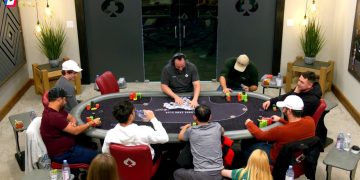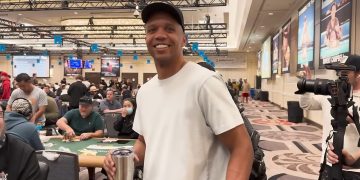I know a lot of poker players. I’m not super close with most of them, but I know them well enough to discuss poker bluff, and I see them at the tables enough to see how they play. I will say this: The overbet all-in poker bluff on the river is not something that is often applied. Only in emergency situations against the right opponents.
This type of poker bluff does happen in mid-stakes poker tournaments, but it’s not as common as you think. This might leave you wondering what type of poker bluff is being used in these tournaments. Since it’s almost impossible to win a poker tournament without bluffing at all, let’s take a look.
Bluffing Weak Opponents
I’m going to write something that is obvious yet many people don’t realize it. The best players out there aren’t looking to get involved in poker hands with other good poker players. That has Ego written all over it, and Ego isn’t how you win. You win by taking the path of least resistance, and the path of least resistance is playing against passive poker players that are the most likely to fold. Bluffing can be as simple as this.
You could apply this approach to your poker rules for winning and do well. However, you need the right table draw if you’re playing in poker tournaments. What I’m about to write might surprise you. Then again, it might not, but it’s definitely true.
As the old saying goes when it comes to poker strategy: “Never bluff an idiot.” There is a difference between a passive player and an idiot. They are, in fact, very different from one another.
Passive Poker Player

A passive player is risk-averse and plays all hands close to the vest. This player keeps the game very simple, which makes him easy to read. As some of you have figured out, I play this way on purpose early in a tournament, which then allows me to use that image to accumulate chips later in a tournament.
I wouldn’t recommend this poker strategy as it requires a lot of patience, no Ego, and excellent timing. In other words, it doesn’t always work. When it does, it’s like a fine piece of art, but it’s usually just graffiti painted on a wall.
Never Bluff an Idiot
An idiot is much different. An idiot can look at the most readable board and not realize what’s going on. They will not take into account any of the following: position, stack sizes, hand ranges, pay jumps, etc. If you try to bluff this person, you’re the idiot. Sorry. Just telling it like it is. And, to be honest, I have been the idiot many times.
That’s not what’s going to surprise you though. What will surprise you in regards to a poker bluff is that you want to bluff the strong players more often, but this only applies if you have set up a tight image. A strong player is much more likely to give you credit for a hand because they don’t think you will come after them unless you actually have a hand.
I probably shouldn’t write the following, but my reputation is that I’m only placing large bets when I have it. This is mostly true, but I use this to my advantage in the right situations. It’s extremely rare that my bluffs are called, which keeps this a secret. Until now, I guess. But if someone is reading this and they’re about to play against me, they’re only going to be more confused, so it’s all good.
I’ll sum up this subheading. If you want to keep the poker bluff simple and not even bother reading other related poker tips below, then only bluff the passive players and strong players. The latter only applies if you have established a tight image. Don’t try to bluff idiots and aggressive players. It’s -EV.
New Territory: The Min-Raise Bluff
Now we’re entering new territory. And it’s much more interesting territory. This is a poker strategy that very few people implement, mostly because they’re looking at the game of Texas Hold’em Poker as black and white.
The GTO players would be steadfast against this move, and I respect their game. At the same time, GTO players are easy to read. Most of the time. They don’t care about that though. They’re looking at the game from a technical standpoint.
If you can read your opponents, then you don’t need to be quite as technical. I have a reputation for good reading skills, but my radar has been off recently. My reputation doesn’t equal the current reality, and I admit that.
Like I said in my previous poker strategy article: I love writing these articles because it allows me to fall in love with the game again. At the present time, live poker presents many distractions and it’s not an escape like it was in the past.
However, I have been down a similar road in the past and got through it. There was a time where I was under the radar and nobody knew my identity. Nobody had a clue who I was for years. That was cool. At the same time, it was a lot of work. When I finally revealed my identity, my poker results improved significantly. Maybe when everything settles down on the business side of poker, the same thing will happen. Hope so.
The Min-Raise Poker Bluff
As far as the min-raise bluff goes, this is one of those poker tips that comes with important instructions. You must realize that the vast majority of poker players will call your min-raise if they have any potential in the hand. On the other hand, the best players are going to fold to your min-raise often because they view that bet as you wanting to extract chips without scaring away your opponent.
I have applied this move many times. The only way a great player is going to call is if they have at least top pair/top kicker. Anything less than that and they’re gone. Here’s the best part. No matter who it is, if they raise, you fold. This tells you that your opponent holds strength. They aren’t going to raise a min-raise unless they hold strength. It also means that you got away from a bad bluff with minimal risk.
Bluff Sparingly

Remember, this is one of the more complicated poker tips. You can call it a poker bluff, a poker trap, or whatever you want. I simply call it a min-raise bluff. It’s a great poker strategy for poker tournaments, but it can only be used sparingly. If you keep using it, you will be discovered. The primary reason I don’t get caught in bluffs often is because I don’t use them often and I try to only use them in the best spots, which keeps me from being discovered.
It’s like stealing something from a candy store. If you steal a chocolate bar (don’t do this in the summer) when the owner isn’t looking, you will probably get away with it. If you do it the next day, you’re still free and clear. You might even get away with it five days in a row. But the owner will eventually see that you’re coming in every day and that you never buy anything.
Then he will take inventory and see that there are chocolate bars missing. The next day you come in to steal that chocolate bar, he will smile at you (never happened before). You will snag the chocolate bar, but it’s a trap. If you only steal a chocolate bar once per month, nobody will notice.
Unique Poker Situation
As some of you know, my first big win (not that big) was a unique situation. I’ll keep this as short as possible. It was during the Harrah’s Cherokee Poker Classic in 2013. It was on a Sunday after the Main Event, as well as after all other events. I drove to Cherokee that morning for that reason. I wanted to be the only person driving to (not from) Cherokee on the last day. I knew that all of my opponents would be tired and/or on tilt.
Many of them would be chasing money. Something came over me and I decided to win the tournament prior to sitting down. There were many non-Ego folds that needed to be made throughout this tournament (tells you something).
When it was down to seven players at the final table, I lost a hand and got up to leave. A Russian kid also at the final table said to the dealer about me, “Wait a second! He has a straight!”
The Russian player wasn’t in the hand (thankfully) and nobody else noticed I had a straight, not even myself or the dealer. I sat back down and ended up head-to-head with that Russian kid. He was a very strong player and had a little momentum. He was a better player at that time, but I might have been more focused. I knew I needed to do something to change the momentum.
Check-Raise Bluff
I check-raise-bluffed for half my stack. He tank-folded. The bluff wasn’t shown, but it didn’t matter. I knew I had him at that point. It was a mental decision. Simple as that. Can’t explain it.
Here’s what I’m trying to tell you. The check-raise-bluff is psychotic, which makes it such a valuable weapon. Think about all the times you have seen someone check-raise. Now ask yourself the following question: What percentage of the time was that check-raise a bluff?
I’m going to bet that number is well below 50%. If you’re really being honest, then it’s likely 10% at the very most. What does this tell you? It means it’s the most valuable weapon in your repertoire!
Picking Your Spots
This isn’t a weapon you should use too often or you will be discovered. There is a professional poker player who uses it all the time and does well, but money isn’t a concern for him, so he just fires more bullets in poker tournaments when he gets caught.
I’ll assume you don’t have unlimited income. If that’s the case, then you need to pick your spots with this move. And as ironic as it might seem, DO NOT try this against bad poker players. This is much more likely to be effective against strong poker players.
A bad poker player won’t evaluate anything. It’s completely random. You need to make this move against someone who looks at poker like a game of chess, without realizing that you outplayed him because you were thinking many steps ahead.
Here’s what’s funny about this. Since my following has increased a decent amount over the past year and a lot of people will be reading this, more people might be inclined to call a check-raise-bluff. You know the correct play, right? Save this play for a few months. Between now and then, check-raise with the nuts to get a call. But … now your opponent read that part as well. You gotta love this game!
How will I play it? If I could, I would insert a shrug emoji here. I’m playing a much different game anyway. It has nothing to do with poker hands.
Calling All Bluffs
One of the best poker tips I can give you is to stay away from hero calls. They feel amazing, like you’re at the top Mt. Everest thumping your chest, which reverberates through the air and reaches the entire world population. Everyone bows down to you from below. But if you think this way, you might want to take it down a notch. You’re usually going to lose on hero calls. You really need to chuck your Ego off the mountain if you want to win in this game.
You should call for two reasons. Both of the following poker tips are known in Texas Hold’em Poker, but one is often undervalued. The first is to read your opponent’s betting patterns. It’s not just how he played this hand, but what have his patterns been on previous hands? People don’t realize they have patterns, but they do.
If it’s the same betting pattern as a previous hand when he had the winner, it’s a fold. If the patterns don’t match, it’s more likely he’s bluffing. But this does not mean you need to call! A missed opportunity is always better than a loss. Those poker chips are your lifeline in poker tournaments. Saving your ammo definitely falls into our poker rules for winning.
Physical Bluffs
The second reason to call is when your opponent has unnatural movements. This doesn’t mean slight unnatural movements, which are obviously him trying to fool you. If everything about them: tight shoulders, eyes not dilated because not excited about the board, still hands, legs that stopped moving (shaking earlier), etc., then it’s likely a physical bluff/tell. These are all subconscious lies being told by the human body. The FBI, CIA, and other intelligence agencies use these reads. And, of course, I’m not giving you the full list. At least not yet.
If you’re at my table, don’t worry. I have so much on my mind right now that I’m not thinking/reading clearly. I’m not a threat. Hope you believe me. It’s not a bluff. No way. I would never do that?
Final Thoughts
Hopefully, the above information will help you with poker strategy for tournaments as well as in traditional poker games. It should be noted that these plays will present more danger in traditional poker games because your opponents are more apt to re-buy.
It’s recommended that you apply them more as a poker strategy for tournaments. And this only pertains to Texas Hold’em Poker. In Texas Hold’em Poker, you can get away with min-raise-bluffs and check-raise-bluffs if used correctly. You’re not going to get away with those moves very often in PLO tournaments. Pick the right spots to set your poker trap and it could catapult you to the final table. Hope to see you at the WSOP.
♠ pokerjournal.org


















Discussion about this post